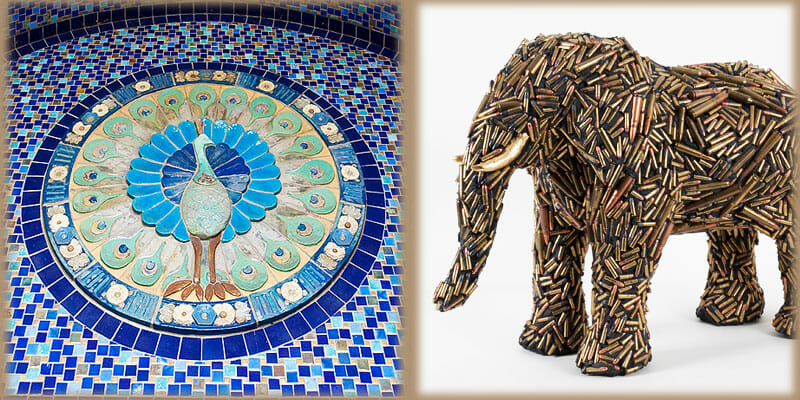Fine Art Collection
There are more than 140 pieces of art throughout the grounds of the Detroit Zoo that showcase humanity’s relationship to animals and inspire a passion and interest in the natural world. Some of the finest examples of this can be found at the Wildlife Interpretive Gallery, which houses the only permanent fine art collection at a zoo.
Above the entryway of the stately glass-domed building is Peacock in Full Display, a Pewabic tile mural created by the firm’s founder Mary Chase Perry Stratton in 1926. Flanking the doors are Two Baboons — bronze sculptures by renowned artist Marshall M. Fredericks.
Among the works inside are two pieces commissioned by the Detroit Zoological Society in 1995. Painter Scott Greenig’s Animal Crackers reflects our belief that we should view the animals with whom we share this planet as nature’s treasures, not objects of entertainment. Bullet Elephant, by sculptor Mary Engel, asks us to consider the horrendous destruction of wildlife caused by some humans. The artist chose to use bullets as her medium, as elephants are shot for their tusks (the reason she used gold as the tusks).
Many more works of fine art grace the main gallery and mezzanine, including a lithograph called Peter’s Cheetahs, notable because its creator Larry Rivers is considered to be the grandfather of pop art. A fallow deer sculpture from Persia dates back to 1250 B.C., and a carved llama-shaped lime container from Peru dates back to 1500 C.E. Another Fredericks work in the building’s rotunda — Family of Man — is a cast aluminum bas-relief, which the artist created in 1955 for the Zoo’s Holden Great Ape House and Amphitheater.
A walk through the Detroit Zoo will reveal an abundance of art, both indoors and out, including two additional works by Fredericks. Leaping Gazelle can be seen to the right upon entering the Zoo; Flying Wild Geese is near the exit.
Establishment in 2001 of the Richard and Jane Manoogian Endowment for Wildlife Art and Interpretation ensures that the Detroit Zoological Society will be able to maintain our fine art collection, acquire new pieces, and deliver impactful and unique educational programs for interpretation for many years to come.







